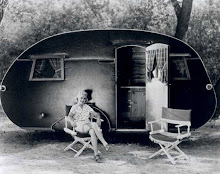When designing a versatile water system, one that you can use boondocking or living high at some RV park, it is important to note that all drips and drops of water must be accounted for at the end of the day. This is what trailer parks call a fully self-contained trailer and many a park requires this.
 Under my kitchen sink...
Under my kitchen sink...Getting Water in…..
Fresh water is provided from an external pressurized source with use of a regulator to provide correct water pressure inside the trailer, or from a fresh water storage tank that you fill up and the use of a water pump. I do not have a toilet so my fresh water goes down the sink to a grey water storage tank that I must drain when full. When a toilet is involved there is an additional black water tank which also needs to be emptied and cleaned. A task that never gets old, I’m sure.
Note: 40-60 psi water pressure is ideal (with a maximum of 100 psi). Carry a pressure regulator with you because the pressure level of city water can be as high as 150 psi which is a dangerous pressure level for your water system components .

Connecting your city water inlet to an external water source
Your water system should have a city water inlet spigot that is easily accessible from the outside of the trailer. You’ll enjoy your water more if you use a hose specifically designed for drinking water and make it a long one (I recommend one 50 footer plus an extra 20 footer backup). You never know how far away the water hookup will be. Use the fresh water hose, exclusively for this purpose without exception, and keep it immaculately clean by storage in a sealable plastic tub. Some places will provide the option to hook up to their sewage system, in which case you can simply hook up a grey water hose to a sewer connection, set your grey water tank valve to open and let your used water drain into the RV park’s sewer system. You’ll need a third hose for this purpose. Don’t get them mixed up, Yuck.
So in short, to get started, simply hook your drinking water hose to the source and to the city water inlet and open your lines to remove any air. If you have a hot water heater tank, make sure it is full before you turn on the heat. Let the lines prime and pressurize. Now you are ready to go.
Water Filters
Like I said, I require a water filter in my system. You can use the filter in a couple of locations. Here are two suggestions.
1.) You can divert cold water to a separate faucet with an under the counter filter attached.
2.) You can connect a filter to the city inlet hose and change your filter all the time.
3.) You can buy both and have the option to use both in the case of really icky water, just be sure that the one at the sink also remove microorganisms such as bacteria.
Using the fresh water tank
If you are not going to hook up, you’ll want to fill the fresh water tank at some point in your trip. Be aware that water weighs ~ 8 lbs per gallon. So a full 40 gallon tank can add about 320 lbs to the dry weight of your trailer. Propane is about 5lbs per gallon. Be sure you don’t go over the recommended weight load for your trailer or rig or throw off the balance of your load. Fresh water from the tank gets pumped into the lines by a 12 Volt water pump located just outside the tank. The pressurized lines then feed the hot and cold water systems which empties into the sink. The sink water goes to the grey water tank. A tankless hot water heater works very efficiently in a travel trailer.
Water level monitors
If you can’t hook up to a sewer line, you’ll need to dump your grey water when it gets full. A monitor system is nice to provide you with information about the levels of water in each tank. A simple model is that conductive probes inside the tank light up when wet to tell you whether the water level is low, medium, or high. Eventually mineral deposits make these probes malfunction and they’ll need to be cleaned. More expensive alternative gauges are available and might be worth it if you use a black water tank in which the probes will quickly deteriorate.
Here is a picture my bed area where I'm going to put in a water system much like the one pictured below it, which I found online.


 And be sure to look at this website for a much more detailed explanation of RV Plumbing. Mark's Fulltime RV Adventure
And be sure to look at this website for a much more detailed explanation of RV Plumbing. Mark's Fulltime RV Adventure

Why don't Moms teach their daughters about plumbing!?
ReplyDeleteGreat blog, best luck to you! I'm also working out a plumbing system for my trailer home now. Nice to come across your site.